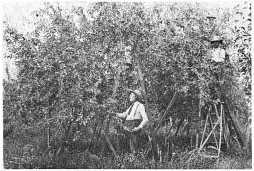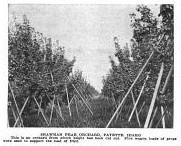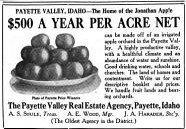FRUIT CROP REPORTS
Payette, Idaho. — Peaches in perfect condition, as are other stone fruits. Apple trees in very good condition, and buds could not be better. — J. H. S. (April 1908, Page 190)
Last year the leaf roller invaded the strawberry beds of this section, some beds being so badly Infested that the crops were destroyed. Can this pest be destroyed by spraying? If so, at what time should the spraying be done, and what preparation should be used?
(2) We have had some experience with red spiders on red raspberries, and would like to know how to combat it.
(3) While working on an orchard last fall I noticed that most of the apples of one variety were covered with black spots, seemingly a black rot. Some said it was bitter rot. What was the cause of this spot, and what can be done to prevent it? — G. H. S., Payette, Idaho. (April 1908, Page 190)
FRUIT CROP REPORTS
Payette, Idaho. —Strawberries 90% of crop; other small fruits full crop. Peaches, 65 to 70%; other stone fruits average crop. Apples full crop. General conditions could not be better. — J. H. S. (June 1908, Page 256)
FRUIT CROP REPORTS
Payette, Idaho. —Heavy crop peaches. Full crop of apples, of very fine quality. No prices yet being made. Our apples will run a larger percent of fancy fruit than ever before. — J. H. S. (August 1908, Page 312)
SIX WEEKS' TRIP THROUGH NORTHWESTERN ORCHARDS
The itinerary of the trip, starting choosing a location from St. Joseph, was as follows: Through Denver to Grand Junction, Colo., with side trips to Montrose, Paonia, Delta, Hotchkiss, Austin, Fruita, and Palisade; stopping at Green River, Utah and next at Twin Falls, Idaho; other places visited in Idaho were Boise, Caldwell, Nampa and Payette; in Oregon the first stop was at La Grande, from which a side trip was made to Cove; then a stop at The Dalles, Hood River, White Salmon, Wash., just across the Columbia River, and Portland.... (October 1908, Page 329)
BOISE-PAYETTE VALLEY.
Leaving the Twin Falls country, the next stop was at Boise, the capital city of Idaho — a splendid city, with a most excellent class of citizens. Some splendid orchards are in the vicinity of Boise, and apples, pears and prunes are being very profitably grown. The accompanying illustration shows orchard scene near Boise, and indicates that the growers are up to date in their methods of orchard treatment.
At the present time an effort is being made to attract settlers to the Boise Valley by the Water Users' Association. The section has been more or less short of water for some years, and the federal government has provided an abundance of water, which will be ready for use for the season of 1909. The lands to be watered all belong to individuals, no government or state land being under this ditch, but the government will furnish water only for forty acres for each settler, and as a result those who have large holdings are compelled to dispose of all but forty acres. The Water Users' Association is composed of all the persons whose lands are to be watered, and is the organization which deals with the government. This organization is seeking to attract settlers who will occupy the surplus lands of its members, and a strong tide of immigration is setting in to take advantage of this opportunity.
When the government project has been finally completed, about 400,000 acres will be watered, 300,000 acres being new land, and the remaining 100000 acres land which is now under irrigation, but in some cases with an insufficient supply of water. Raw land sells for from $25 per acre upward; improved lands for from $100 per acre upward, and orchards for from $500 per acre up.
The lands to be watered by this project are in what is known as the Boise and Payette valleys, and are tributary to the towns of Boise, Caldwell and Nampa. Boise is the largest city of the group, but perhaps more of the land lies tributary to Nampa. This little city is on the main line of the Oregon Short Line railway, and in the center of a splendid farming and fruit country. Comparatively few old orchards are to be found in the vicinity of Nampa, but all that we visited are loaded with fruit this year. Only the scarcity of water has prevented the development of this splendid section.
A trolley line connecting Nampa with Boise is almost completed, and other interurban lines are being projected. A beet sugar factory is in full operation, the supply of beets being drawn from all the surrounding country. Beets have been profitable until the last two seasons, and now growers are claiming that in furnishing seed the factory has substituted a variety which does not yield as large roots as the seed used at the time the contracts for growing the beets were made. As a result the acreage of beets will likely be reduced another year.
At Nampa we met Silas Wilson, formerly of Atlantic, Iowa, and who was long connected with the horticultural societies of that state. Mr. Wilson says he believes Southern Idaho is the place where the Jonathan apple reaches its highest development, and where crops are practically sure every year. A number of orchards have been planted around Nampa the past season, and more will be planted next spring. (October 1908, Page 366)
PAYETTE. IDAHO.

JONATHAN TREE IN J. H. SHAWHAN ORCHARD, PAYETTE, IDAHO
Capt. Shawhan standing on the ground. The men in ladders are thinning these trees for the second time.
Jonathan trees in this orchard will average twenty boxes per tree.
At Payette we found a valley which is perhaps more developed along horticultural lines than any other part of Southern Idaho. Payette has an abundance of water, and orchards are more numerous. As a rule, they have also received better care. Captain J. H. Shawhan, formerly of Iowa and Kansas, is a member of The Fruit-Grower Family, and in company with other gentlemen representing the Commercial Club he piloted us around through the orchards. Apples, pears, prunes and peaches constitute the principal fruit crops in the vicinity of Payette.
Captain Shawhan has a splendid pear orchard, which has been wonderfully profitable. Varieties are Bartlett, Flemish Beauty, Clairgeau, Anjou and Howell. Blight has appeared in this orchard, but Captain Shawhan has kept it under control by cutting away the blighted portions of the tree, and in winter he goes over all the trees very carefully and cuts out the cankered spots, in which the disease winters over from one season to another.
This orchard is the best example of heroic pruning we have ever seen. Some trees had been cut half away, before the course of the disease had been checked, but it was sufficient to know that it had been checked at last. The accompanying illustration shows what a splendid crop of pears was being matured at the time of our visit. Bartletts were not yet ripe, but the fruit was of unusual size and quality; the Clairgeau and Flemish Beauty were very large and very well colored.
Anjou pear is coming to be more popular with growers, for it has been found that while the trees are rather shy in bearing early, they become more prolific as the trees become older, and the pear always sells on market. Mr. Shawhan has been successful in growing pears, simply because he takes steps to control blight, while other growers have not been willing to go over their trees as carefully as they should, to keep the disease in check.
Mr. Shawhan's pears are next his apple orchard, and he says he is about convinced that this is a mistake—certainly he believes it a bad plan to plant pears among the apple trees, for this makes it harder to control the disease, for it spreads from the pears to apple trees, and vice versa. As it is, Mr. Shawhan inspects his apple trees as carefully as he does his pear trees every winter.

SHAWHAN PEAR ORCHARD, PAYETTE, IDAHO
This is an orchard from which blight has been cut out. Five wagon loads of props were used to support the load of fruit.
This year the apple trees in this orchard will produce about 6,000 boxes, Jonathan trees averaging about twenty boxes per tree — and this variety is the one most largely planted. Five or six carloads of pears will be shipped, so that on a twenty-acre ranch there will be a good crop of fruit of fine quality.
Payette has a good shipping association, which packs apples in the orchard, under the supervision of an inspector from the association. Prunes are packed at a central packing station. This year Payette will ship perhaps 300 cars of apples and about 85 of prunes. The Payette-Boise valley will ship a total of about 300 carloads of prunes, many of them going to England, where the fruit is esteemed very highly.
The growing of canteloupes and watermelons is an important industry, and car-lot shipments are made throughout the season, the melons being of very high quality.
Lands are quoted at from $150 to $200 per acre upward. Prices are generally regarded as being low, simply because the fruit industry has not reached its highest development as yet. Pavette has an abundance of water, and new orchards are being planted very rapidly. Apples and Italian prunes are the principal crops, both of which grow to perfection.
DRYING RASPBERRIES ON BUSHES. When the editor of The Fruit-Grower visited the Payette valley three years ago he came back with a story which was almost beyond belief — indeed, we don't believe many of our readers did believe the tale, but it is true nevertheless. It was the story of a man who evaporates blackcap raspberries on the plants. This gentleman has enlarged his acreage, until now he has perhaps thirty acres. The crop is cultivated iust as though the fruit were to be picked — but it is not picked, but dries up on the vines. No rains interfere with the drying of the fruit, and when the evaporation process is completed the old canes are cut out, just as they will have to be cut out anyway, and are hauled to the storage house, where a specially built machine threshes the dried raspberries from the canes, runs them through a fanning mill to remove the leaves, etc., and the product is ready for market. At the time of our former visit this gentleman used a flail to separate the fruit from the canes, but he has devised the machine now in use, and it works well. This is the only case of this kind we have ever heard of, but this is a true story. (October 1908, Page 366-367)
ADVERTISEMENT (December 1908, Page 457)

